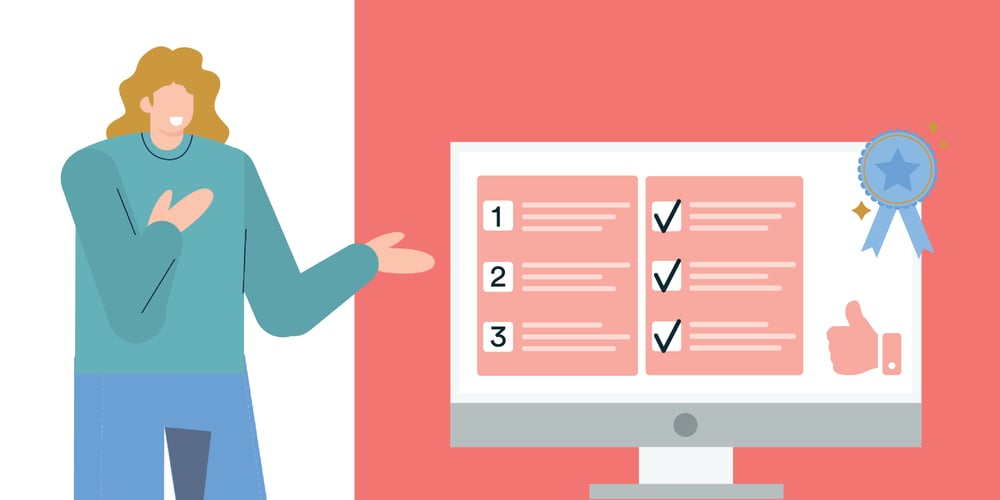Free Course Sales Page Template + How to Build a Page That Sells More
by Todd Parmley
COO, eWebinar
Last updated July 16, 2021
You have surely thought a lot about how to market your course, and even explored hosting a sales presentation using an automated webinar, but if you’re looking to scale sales of your program, it might be time to rethink how you’re making the case for people to take your course. The sales page for your course plays a big role in helping those who’ve discovered your course decide if it’s the right fit for them.
Creating a course sales page that generates sales is as easy as having the right course sales template. This article will help you create the best online course sales page by covering the following:
- Top 3 questions to ask yourself about your course sales page
- Types of course sales pages
- 12 things to include in your course sales page template
- The only course sales page template you’ll ever need
- Course sales page worksheet: planning your page
Before we get into your online course sales page template, let’s get into some questions you need to ask yourself about your page.
PRO TIP: Are you a Thinkific user? If so, we’ve written a guide to help you learn how to use eWebinar to promote your Thinkific course.
Top 3 questions to ask yourself about your course sales page
For your online course sales page to generate any sales, you have to be able to effectively communicate the value in your course. The easiest way to do that is to clearly define your unique value proposition and how you plan to communicate it, which can be done by answering these three questions:
1. Who should take your course?
The first component of your value proposition is your target market. Ask yourself who your course was created for. You want the struggles and aspirations of your ideal customers to be clear, so you can cater your course towards them.
Example answer: “My course helps digital entrepreneurs.”
2. What will it help them do?
Next, you need to identify what customers of your course will be able to accomplish. Be clear about what knowledge they’ll acquire by completing the course and what problems they’ll be able to solve. Also establish what specific outcomes they can expect by implementing the skills they’ve learned.
Example answer: “My course helps digital entrepreneurs learn to automate their sales.”
3. Why is that beneficial to them?
Your value proposition should end with the benefits of taking your course. What do they have to gain from achieving the outcomes presented in your course? Communicating how the skills and knowledge acquired will improve their lives is key to persuading them to enroll.
Example answer: “My course helps digital entrepreneurs learn to automate their sales so they can spend more time growing their business and with their family and friends.”
Types of course sales pages
To get the most out of your online course sales page, you need to decide which type of page is best suited to selling your course. Here are the three types of course sales pages.
Text only sales page
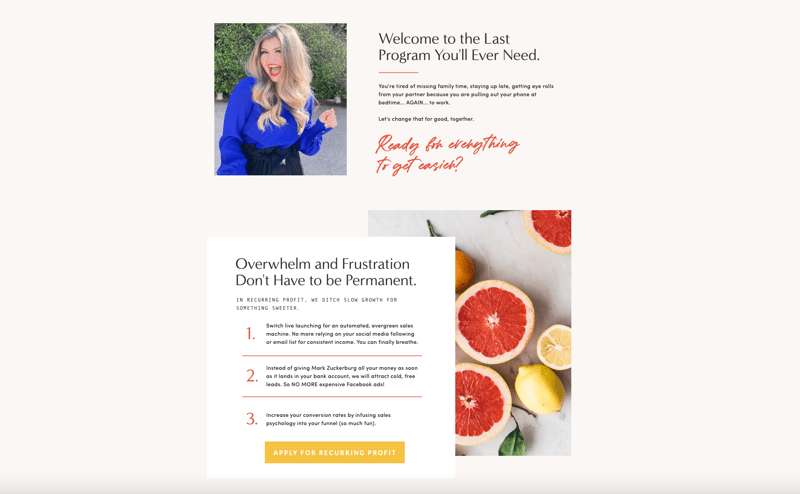
Image Credit: Recurring Profit
A text only sales page will predominantly use text to relay information on the course. They might use images and design elements to help highlight information. These types of sales pages are also called long-form sales letters, as they communicate information of the course by using a lot of text.
When this type of sales page is right for you: You need more time to produce quality videos that promote your course for the time being, or need a landing page that promotes a webinar (or better yet, an automated webinar like the kind you can make with eWebinar).
PRO TIP: Create a second sales page for your automated webinar. Automated webinars are a great way to increase your reach and promote your course, but you still need to convince potential students to register for a session. Since this is a video event, use a text-only sales page to introduce your webinar and convince them why it’s worth their time.
Text and video sales page
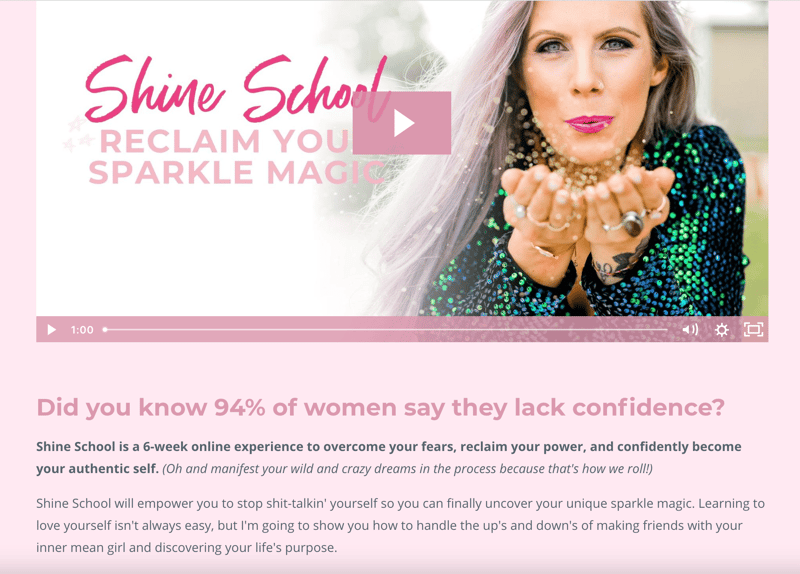
Image Credit: Shine School
A text and video sales page uses a combination of the two. This gives potential customers the choice between reading the text, watching the video, or both to help them learn what they need to know and make a decision on whether or not to enroll. If you opt to use this type of sales page, it’s important to use much less text than you would on a text only sales page.
When this type of sales page is right for you: You want to personally introduce yourself to potential students and give them a sense of what the lessons will be like.
Video sales letter
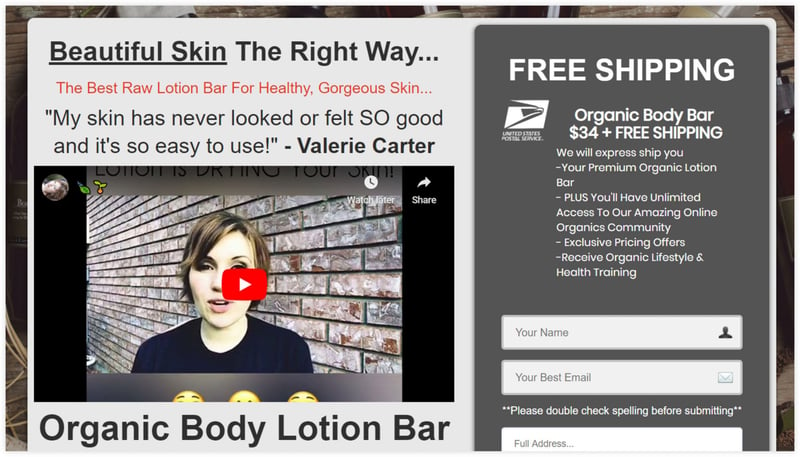
Image Credit: ClickFunnels.com
A video sales letter (VSL) is used to sell a course using only a video. VSLs can be thought of as the video form of a long-form sales letter and are typically found on websites, landing pages, emails, and digital ads with a visible link to make a purchase. The goal with a VSL is to keep it as short as possible, while still communicating all the important information your potential customers need to know.
When this type of sales page is right for you: You want to create a highly engaging, dramatized sales letter to motivate potential students, and you can do this clearly and concisely.
12 things to include in your course sales page template
Planning a sales page for your course can be overwhelming. There’s a lot of information you need to convey and it needs to be presented in a way that keeps your audience reading. To help attract new customers, here’s everything you should include in your course sales page template.
1. A headline
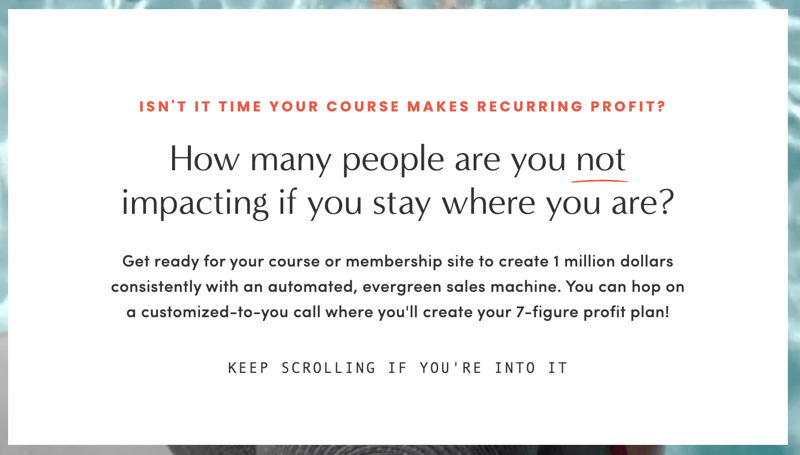
Image Credit: Recurring Profit
The headline is used to grab and hold your reader’s interest. It should make it clear who you’re selling to while also being clever enough to make the readers want to read on and learn more about your course. You don’t necessarily need to mention your course in the headline, but instead focus on appealing to your target audience and convince them that they’re about to learn more about a solution they need.
Best for courses: All types
Why you need this on your course sales page: It captures your reader’s interest immediately.
2. An opening story
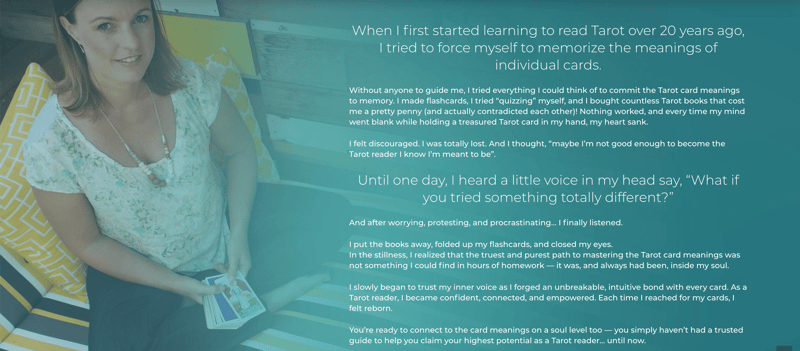
Image Credit: BiddyTarot.com
Once you have the attention of your viewers, you want to pull them in further with the opening story. Share a story they can relate to — either your own or a client’s — that shows how the knowledge learned in your course was used to overcome the struggle they’re experiencing. You want to count on empathy to pull potential readers in and help them see themselves in the experience being described.
Best for courses: That are for personal transformation and/or offer membership
Why you need this on your course sales page: Helps readers visualize themselves succeeding with your help.
3. Bullet-points of the benefits
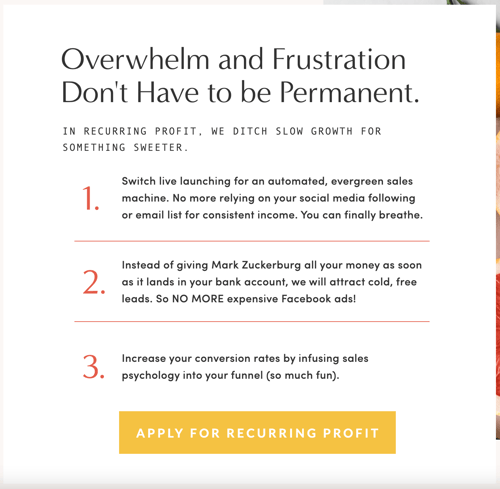
Image Credit: Recurring Profit
Next, you want to start selling your course. One great way to do this is with bullet-points for each of the benefits students will gain by enrolling in your course. Readers need to quickly see the value of your course, so this will help this information stand out and be easily digestible. Make sure each bullet-point is brief but still makes it clear how your course will improve their lives.
Best for courses: That are introductory, focus on transformation, and/or offer membership
Why you need this on your course sales page: Helps readers see the value in your course quickly and efficiently.
4. An introduction to your course
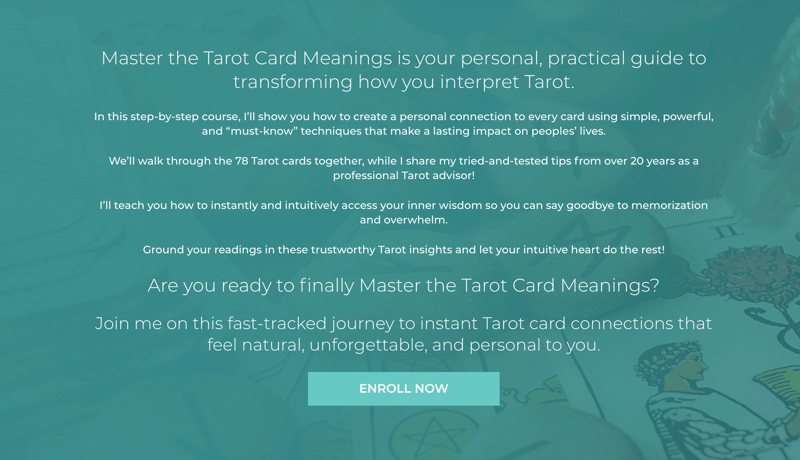
Image Credit: BiddyTarot.com
Along with your bullet points, you also need to introduce your course as a solution to the reader’s problem. Explain what your course teaches and everything that’s included in the course, then expand into the modules within the course and what they’ll learn in each. Remember to touch on the benefits of everything they’ll be learning, so they’ll be able to see how everything in your course will make a difference for them.
Best for courses: All types
Why you need this on your course sales page: Paints the full picture of what will be gained from taking your course.
5. Bonuses
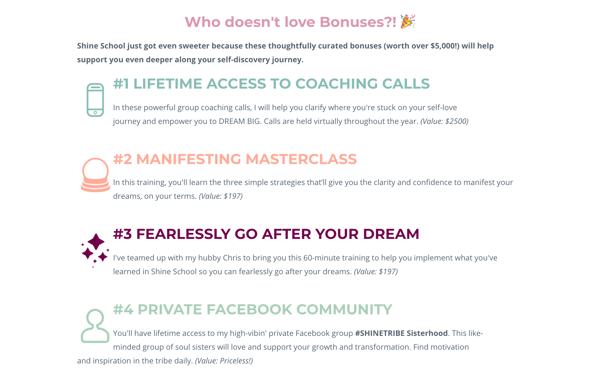
Image Credit: Shine School
Be sure to entice potential students by listing any bonuses you offer with your course. Whether it’s coaching calls, discounts, digital products, or certification, making this information known helps to add even more value to your course and really helps readers see your course as an exciting learning experience. You might want to consider including a dollar value with each bonus, so potential customers can see the true monetary value of the experience you offer.
Best for courses: That focus on personal transformation and/or offer memberships
Why you need this on your course sales page: Helps increase the perception of value in your course.
6. Testimonials
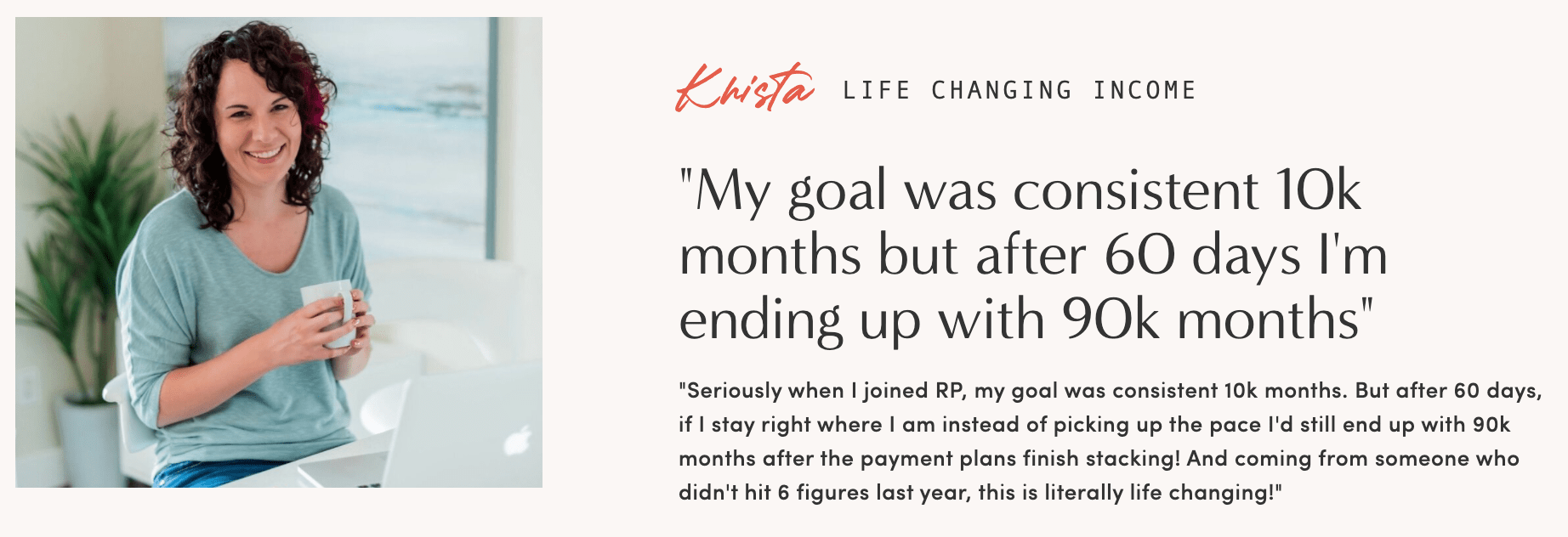
Image Credit: Recurring Profit
Now that you’ve presented your solution, you need the proof that your course can actually help. Testimonials are a great way to prove your course’s worth. Using quotes from past students, along with their name and photo, shows that real people were able to benefit from what you have to offer and provides an unbiased look into the value of your course.
Best for courses: All types
Why you need this on your course sales page: Provides third-party proof of the effectiveness of your course.
7. Your bio
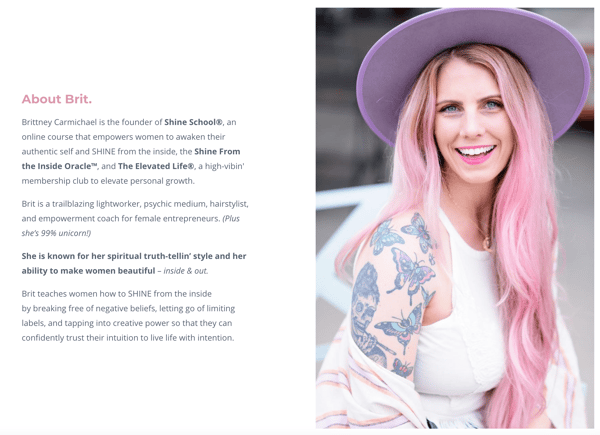
Image Credit: Shine School
Potential students will be wondering why they should take your course over another. This is where including your background is essential. Including a quick bio about yourself and/or your company is a great way to establish credibility and show readers that they can trust you to guide them to their desired solutions. Including information about how you struggled and overcame the problem you offer a solution for will also contribute to your expertise, while humanizing you at the same time.
Best for courses: All types
Why you need this on your course sales page: Establishes credibility in you as the course provider.
8. FAQs
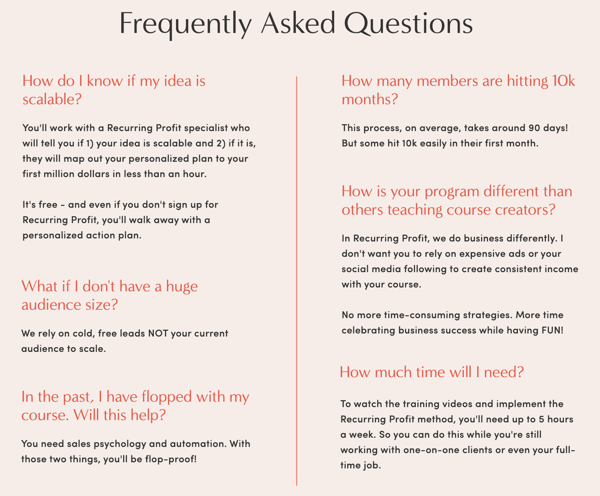
Image Credit: Recurring Profit
An FAQ section is a great way to help potential customers commit to enrolling in your course. Unanswered questions can result in them choosing not to purchase, so it’s important to get ahead of this. Select between 5 to 10 of the most commonly asked questions you get from people considering your course, and provide the answers in this section. Providing readers with all the information they need is the best way to get them to commit.
Best for courses: All types
Why you need this on your course sales page: Provides answers to questions that, left unanswered, would discourage purchases.
9. Pricing information
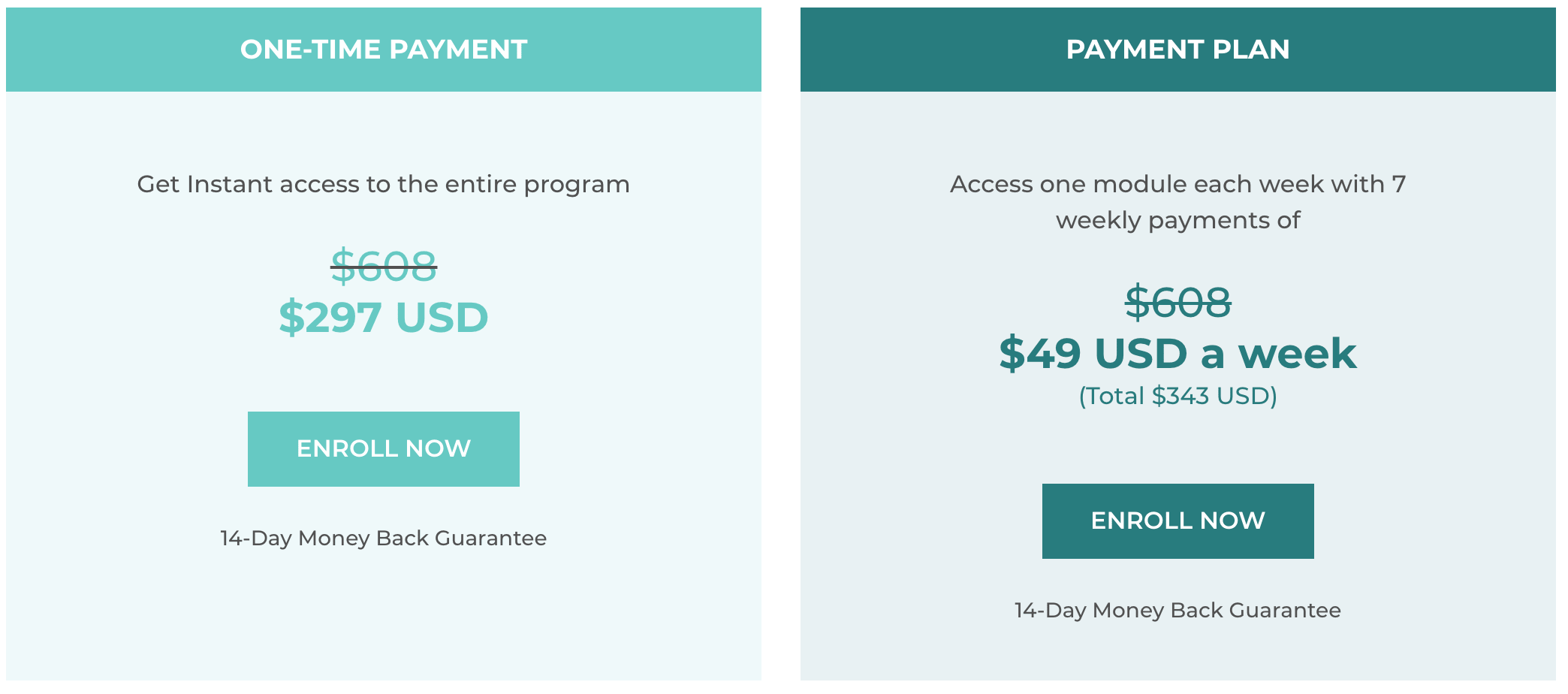
Image Credit: BiddyTarot.com
Now that they’re invested, it’s time to introduce the price(s) of your course. How much customers need to spend is a big deciding factor in whether or not they’ll make a purchase, so make this information as clear as possible. If you offer multiple payment options, such as full price and installments or multiple tiers, make sure the differences between each option are also clear. Also, if you offer full price and installments options, be sure to highlight any discounts they’ll receive for paying the full price upfront.
Best for courses: All types
Why you need this on your course sales page: Prices need to be clear in order to build trust and help customers make a decision.
10. A risk reversal
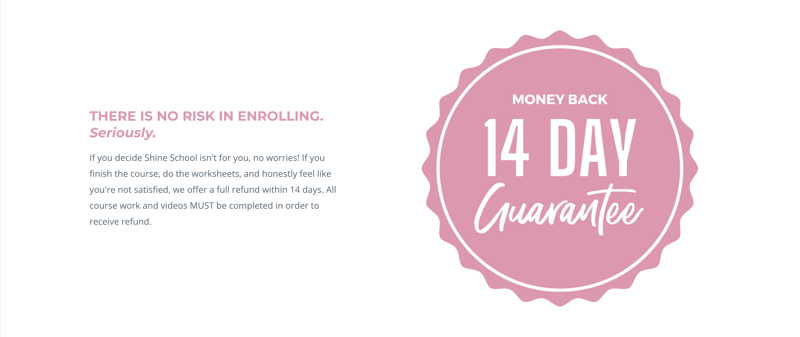
Image Credit: Shine School
No one enjoys feeling like they’ve wasted their time or money, and this is something that can make customers hesitant to commit to purchasing your course. Following your pricing information with a risk reversal helps readers see your course as less of a risk to their time and wallet and will make them more likely to enroll.
Examples of risk reversals include money-back guarantees, better than money-back guarantees, and emotional guarantees. Offer a guarantee that works best with your course structure and benefits.
Best for courses: All types
Why you need this on your course sales page: Eliminates perceived risk that could stop readers from enrolling in your course.
11. A P.S. section

Image Credit: Shine School
The final (and an optional) section of your course sales page template is the P.S. section. This serves as a final, personal note from you to quickly summarize the value of your course and make one last attempt to convince readers to purchase. If a lot of readers skim your sales page, this small section can serve as a last attempt to motivate them to sign-up. You can also consider providing contact details and inviting indecisive readers to reach out with their questions.
Best for courses: That are for personal transformation, are introductory, and/or offer memberships
Why you need this on your course sales page: Final attempt to establish connection and demonstrate value.
12. A call-to-action (CTA)
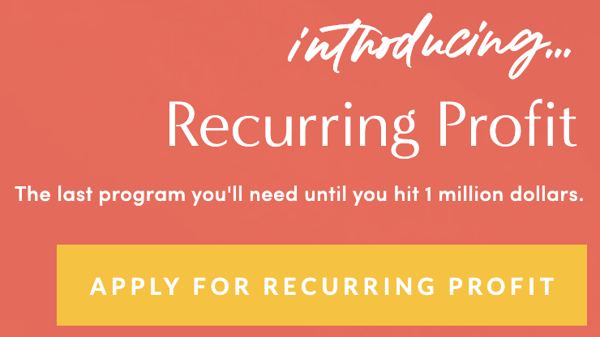
Image Credit: Recurring Profit
While you definitely want this at the very end of your sales page, you should also look for opportunities to scatter a CTA throughout your course sales page. Establishing a clear CTA helps students initiate the next step of enrolling in your course without any questions on how to do so. Providing multiple CTAs that link to your enrollment page throughout the sales page will also help students to easily commit to enrolling at their point of highest intent.
Best for courses: All types
Why you need this on your course sales page: Provides a clear next step and encourages potential students to follow through with enrolling.
The only course sales page template you’ll ever need
To help you visualize what your course sales page should look like, we’ve created our own online course sales page template for you to use. We’ve taken our How to Sell Your Course on Autopilot Without You webinar and imagined what a text-only sales page might look like for it if it were a full online course.
Check out our sample course sales page template here.
Course sales page worksheet: planning your page
Now that you know what information to put on your course sales page, you can start planning it. If you could use some additional help organizing the information you should be including, download our free, fillable course sales worksheet:
Or you can follow all of the steps below:
What type of sales page do you want to create?
Choose one of the following:
- Text only
- Text and video
- Video only
What is your unique value proposition (UVP)?
Answer the following questions to craft your UVP.
- Who should take your course?
- What will it help them do?
- Why is that beneficial to them?
Your UVP:
Write out your UVP in the following format: My course helps [1] learn to [2] so they can [3].
Keep this in mind when filling out the rest of this worksheet!
Page Content
Complete this section to generate the content for your course sales page.
Headline
Create a catchy headline that will grab your readers’ attention and communicate benefits.
Opening Story
What was the problem you or a client was facing? How did this problem negatively affect your/their life? How did you overcome this problem/how did your knowledge help them overcome the problem?
Benefits
What are the benefits of taking your course? What outcomes can people expect?
Course Description
Introduce your course. Why did you create it? What topics/themes will be discussed? How will it be taught?
Modules
Describe each of the lessons in your course.
Bonuses
Does your course come with any bonuses? Briefly describe them.
Testimonials
Include quotes from past students of your course.
Your Bio
Write a brief biography about yourself detailing your relevant background experience. Include anything that will help establish your credibility, like the struggles that led you to the solution you teach.
FAQs
What are some frequently asked questions you receive about your course that people need answered before buying? Prepare your answers for them.
Pricing
What are your pricing options? What’s included with each?
Risk Reversal
What are you offering as a guarantee? What are the terms?
P.S. Section
Summarize the value of your course. What about your course do you want readers to take away?
So now you know everything about creating an online course sales page, including how to determine your course’s value proposition, the types of course sales pages, and what needs to be included on your page. If you want to learn how you can get to your first $1 million by automating your online course sales, check out this webinar.
Want to see how eWebinar can help you sell your course to a wider audience? Sign up for a free trial today.
How to Sell Online Courses on Autopilot
TABLE OF CONTENTS




